In 1743-5 Richard Pococke published his multi-volume account of his travels in the Near East, 'A Description of the East and Some other Countries.' The second volume included a plate of some inscriptions he copied in Citium in Cyprus. He described it as follows "the walls seem to have been very strong, and in the foundations there have been found many stones, with inscriptions on them, in an unintelligible character, which I suppose, is the antient Phoenician..." (v. II pg. 213)
Here is his plate:
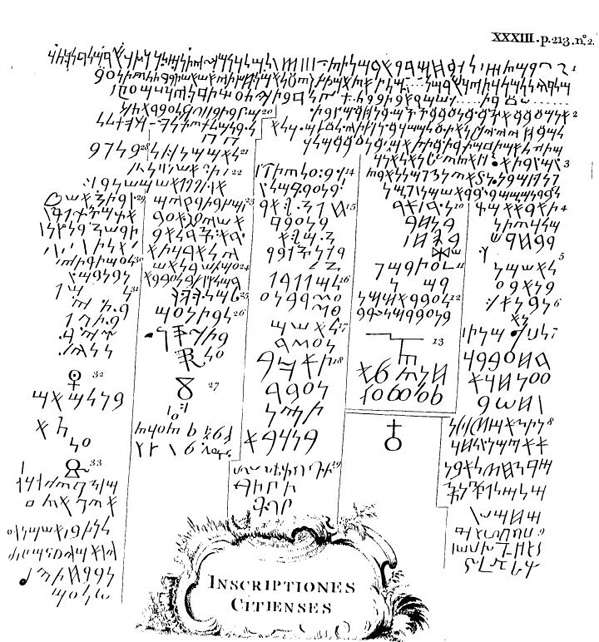
This post concerns the second inscription:

Remember, he describes them as unintelligible and has to guess which alphabet it is. His transcription certainly may contain error.
In 1764 the Abbe Barthelemy wrote an article about these inscriptions in vol. 30 of the Histoire de l'Académie royale des inscriptions et belles-lettres. Barthelemy was an expert in the Phoenician alphabet, and is credited with being the first European to decipher Carthaginian inscriptions which he did in 1758 with the aid of a dual Greek and Carthaginian inscription from Malta. (The alphabet of Carthage is very similar to the Phoenician alphabet, which in turn is very similar to the ancient Hebrew. For all intents and purposes they are one alphabet.)
In his article he read Pococke's transcription the following way:
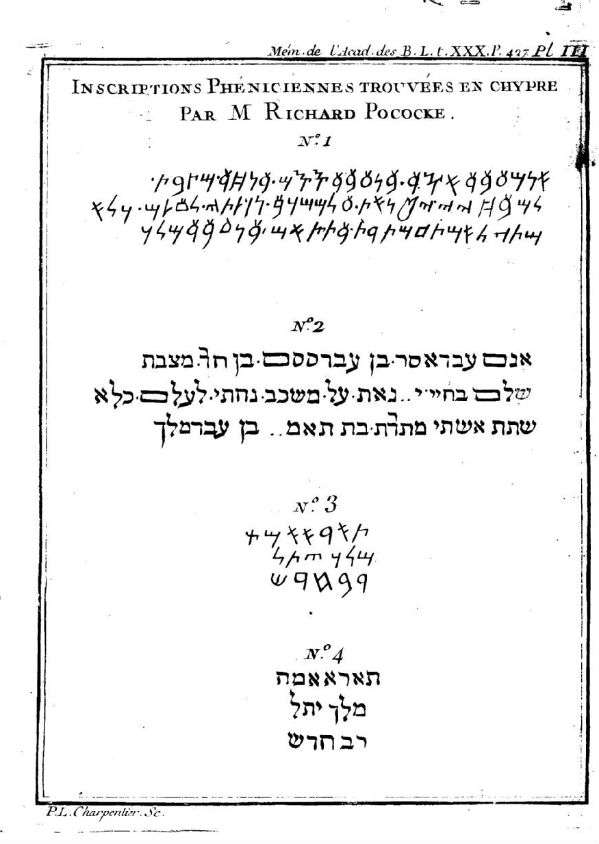
John Swinton believed that Barthelemy had completely misread the inscription, and published a long article in the Philosophical Transactions of 1765 -- 56 pages -- from a paper read in December of 1764. Here is what he came up with:
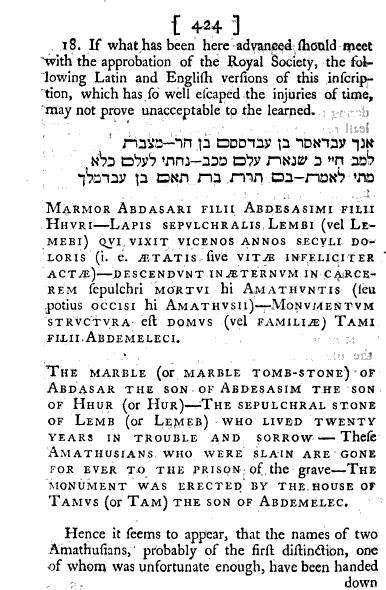
Interestingly, he read the first three letters אנך as "onyx," which he translates here as "a marble." That's pretty imaginative and even brilliant. This was more than a 100 years before the Mesha Stele was found, so I suppose אנכי did not seem obvious. But it would not take 100 years before someone read it that way.
In 1801 Akerblad wrote a small book called Inscriptionis Phoeniciae Oxoniensis nova interpretatio (Pococke transcribed no less than 33 inscriptions in 1738. In 1750 an English physician named Porter had brought one of them -- this one, carved into white marble -- to Oxford).
Here is his reading:

Edit: In the comments Nachum asked f0r more clarification, and I confessed that I didn't know anything about subsequent study of this, and other Phoenician, inscriptions. However I learned that the great Gesenius devoted a lengthy book to the topic, to the topic called Scripturae linguaeque phoeniciae monumenta in 1837.
Below is his reading, as well as a chart of the relationship of the alphabets:
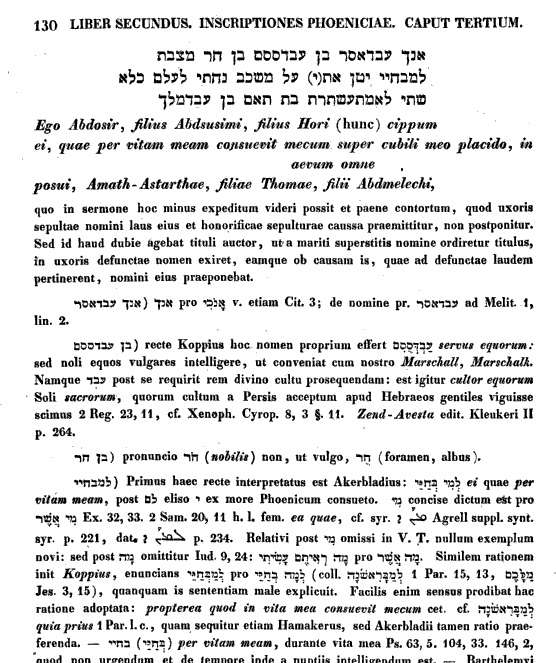
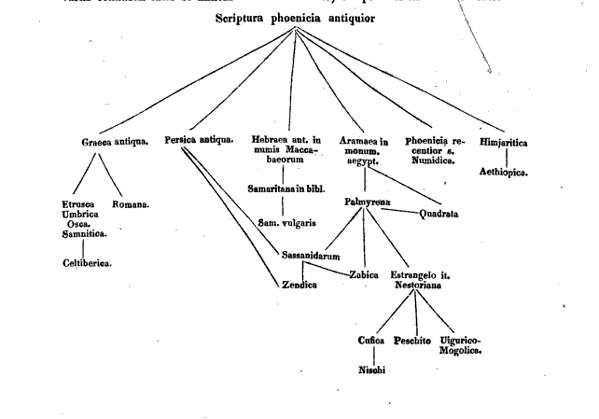
Reflecting the thinking of the time, Shadal writes in his introduction to the Pentateuch (pg. 7), which he wrote around 1830 for his students in the Rabbinical Seminary of Padua "Ne altra lingua che l'ebraica avevano i Fenici, i popoli cioe di Tiro e di Sidone, dei quali monumenti tutti che ci rimangono, colla cognizione della lingua santa spontaneamente s'interpretano," which means that the Jews and the Phoenicians spoke the same language, which is why a knowledge of Leshon Hakodesh is what is required to understand their inscriptions.
Why does he mention this? A great part of this introduction is spent refuting the critical theories of his time, and earlier, which maintained that Moses only wrote a part of the Torah, if that. One of the observations made by critics in his time is that the language of the Hebrew Bible, from beginning to end, is so uniform that it is impossible for them to have been written over a period of 1000 years, for no other language furnishes an example like it! Given this, the likely explanation was that the Torah was not so early, but written hundreds of years later, in the time of David. In other words, by compressing the period of biblical literature into a much smaller time frame, the lack of linguistic evolution of biblical Hebrew can be explained. This is kind of amazing, in light of the opposite posture maintained today. Indeed, Hebrew linguistics has not remained static in 180 years. In any case, Shadal's contention is that while it is essentially true that biblical Hebrew does not exhibit anything like the evolution of other languages, this can be explained in the following way. Languages evolve mainly through interaction with other peoples, friendly or hostile. For example, when Latin met the Northern countries, it evolved into the respective languages of those places (Spanish, Italian, French). Similarly, in his own time, the French, English, German and Italian languages were continually loaning words to each other, due to the heavy interaction between these peoples. However, for most of the biblical period Israel only had interaction with neighboring peoples who also spoke what was essentially Hebrew. Only when Aramaic speaking invaders from the North came on the scene did Hebrew begin to take on an Aramaic flavor, a development from which it never ceased.
Getting back to Gesenius, the book which I linked to above, contains dozens of amazing plates at the end. Have a look:
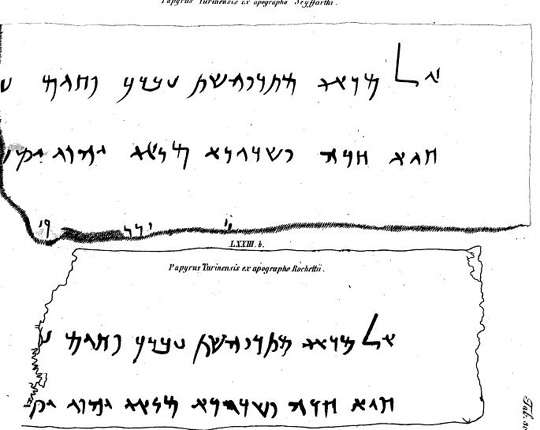


An Israelite or a Canaanite? Do we have any way of knowing, or of what year it would be from?
ReplyDeleteCanaanite, I guess. This was in Cyprus after all.
ReplyDeleteI don't know what the latest scholarship on these inscriptions are (or if there *is* any "latest" scholarship; I honestly don't know if they've been revisited much these past 200 years), but Akelblad conjectured that they date to 300 BCE, but also allowed that he won't object if someone thinks they're 100 years older than that.
As for ways of knowing, the art-science of palaeography is much further developed today, with many more examples of inscriptions to study. There's a good chance, I'd think, that the particulars of this alphabet are pretty well understood, which means that it can be dated.
ReplyDeleteOh, Cyprus. Missed that. The woman's name is also a bit of a giveaway, but you never know.
ReplyDeleteThanks for the extras!
ReplyDeleteI'm not sure I make out his Latin properly, but he doesn't mention (it may not have been known) that the Indian scripts (and from them, most of the Asian scripts) also derive from Phoenician. In fact, outside of Chinese-derived writing (basically Chinese and Japanese and possibly Korean), all living writing systems in the world derive from Phoenician. (Even artificially created Native American scripts do, in their own way, and there are even claims that the Chinese scripts- certainly Korean, which is an alphabet- were at least influenced by Phoenician derivatives.)